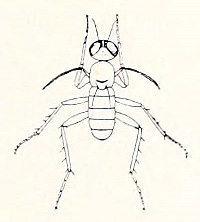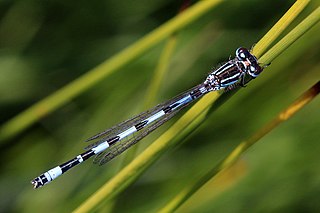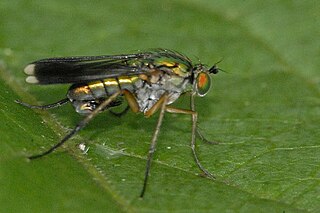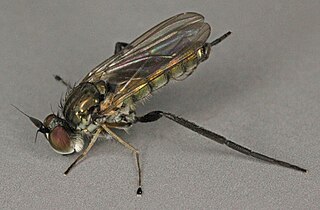
The River Teign or is a river in the county of Devon, England. It is 31 mi (50 km) long and rises on Dartmoor, becomes an estuary just below Newton Abbot and reaches the English Channel at Teignmouth.

The Eurasian beaver or European beaver is a beaver species that was once widespread in Eurasia, but was hunted to near-extinction for both its fur and castoreum. At the turn of the 20th century, only about 1,200 beavers survived in eight relict populations in Europe and Asia. It has been reintroduced to much of its former range, and now occurs from Spain, Central Europe, Great Britain and Scandinavia to a few regions in China and Mongolia. It is listed as least concern on the IUCN Red List, as it recovered well in most of Europe. It is extinct in Portugal, Moldova, and Turkey.

Dolichopodidae, the long-legged flies, are a large, cosmopolitan family of true flies with more than 7,000 described species in about 230 genera. The genus Dolichopus is the most speciose, with some 600 species.

Empididae is a family of flies with over 3,000 described species occurring worldwide in all the biogeographic realms but the majority are found in the Holarctic. They are mainly predatory flies like most of their relatives in the Empidoidea, and exhibit a wide range of forms but are generally small to medium-sized, non-metallic and rather bristly.
The Manx robber fly is one of 7,100 species of robber fly or Asilidae known throughout the world, and one of 28 asilids known to occur in the British Isles.

Campsicnemus mirabilis is an extinct species of fly in family Dolichopodidae. It was endemic to the Hawaiian Islands.

Coenagrion mercuriale, the southern damselfly, is a species of damselfly in the family Coenagrionidae. It is found in Algeria, Austria, Belgium, France, Germany, Italy, Liechtenstein, Luxembourg, Morocco, the Netherlands, Portugal, Slovakia, Slovenia, Spain, Switzerland, Tunisia, and the United Kingdom. Its natural habitats are rivers and freshwater springs. It is threatened by habitat loss.

Rhaphium is a genus of flies in the family Dolichopodidae. It is the largest genus within the subfamily Rhaphiinae, with over 200 species currently known.
Systenus is a genus of fly in the family Dolichopodidae.

Tring Reservoirs is a group of four reservoirs close to Tring on the border of Hertfordshire and Buckinghamshire, England. Their purpose is to feed the Grand Union Canal.

This is an impartial and comprehensive record list of 292 British record freshwater fish, past and present, involving 57 different species/sub-species of fish caught using the traditional angling method of rod and line. Records to include the angler, species, weight, date, venue, also referenced with a recognizable publication. The list is intended to include all categories of fish caught by anglers, that enter freshwater including and some migratory sea fish. The time since last record fish was caught is 212 days.

Hydrophorinae is a subfamily of flies in the family Dolichopodidae. According to Germann et al. (2011), the subfamily is polyphyletic.

Sciapodinae is a subfamily of flies in the family Dolichopodidae.

Poecilobothrus nobilitatus or semaphore fly is a species of fly in the highly studied family Dolichopodidae. P. nobilitatus are popular study subjects because they are easy to recognize and are of large size. They mainly reside around ponds and wet lands, where most of their hunting and mating take place. Their mating ritual is highly studied due to their distinctive mate selection behaviors.

Rhaphium appendiculatum is a species of fly in the family Dolichopodidae. It is found in the Palearctic.

Rhaphium crassipes is a species of fly in the family Dolichopodidae. It is found in the Palearctic.

Syntormon pallipes is a species of fly in the family Dolichopodidae. It is found in the Palearctic, Oriental and Afrotropical realms. In 2019, the mitochondrial genome of S. pallipes was sequenced, as the first representative of the subfamily Sympycninae.

Windmill Hill Cavern is a limestone cave system in the town of Brixham, Devon. It was discovered in 1858 and later excavated by a team led by the geologist William Pengelly, who found proof that humans co-existed with extinct British fauna.















